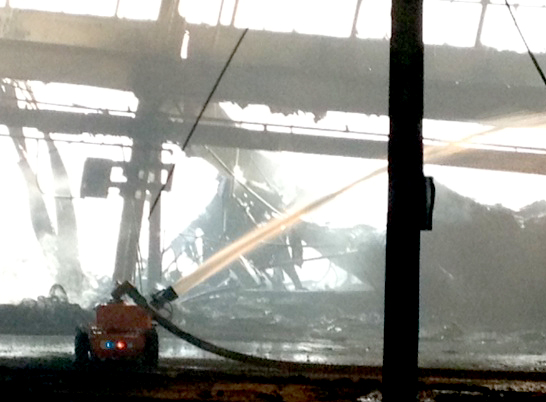
(Photo: one of the Purdue firefighting robots is able to get near the hot spots during a fire in Hoopeston, Ill., this summer.)
Robots are now part of the firefighting squad at the Purdue University Fire Department.
Korean technology, combined with great innovation and input from Eric Matson, associate professor of computer and information technology, has led to a new breakthrough in fire fighting technology.
The robot looks like a small army tank and is controlled by a handheld remote. It can withstand immense heat and carry a fire hose further than any firefighter, making it an ideal resource in controlling and extinguishing fires.
The robot not only prevents firefighters from risking their lives, but also allows the fire teams to find the source of the fire faster than was possible before.
“I usually work for six to eight weeks every summer in Korea. When I was over there one of the professors approached me and said he thought we could make a pretty good partnership with the company supplying these robots. They really wanted to get their product out on the market in the U.S. From there we really just improved their technology and ideas and it all started to take off,” Matson said.
With the advancements that Eric Matson and the firefighting squad have made, they have been able to put the robot through numerous tests and recently use it in a real fire.
“Out in Hoopeston, Illinois, there was a huge fire in an old tire warehouse. It ended up taking a week to completely put it out, but we were able to send out the robot and really put it to good use. Not only does it make it safer for the fire fighters, but it makes it easier to find the source the fire is coming from,” Matson said.
The robot has a heat censor camera attached to its front, allowing the person controlling it to extinguish the fire and potentially find any people who could be trapped in the blaze.
Although the fire fighters were hesitant at first to let a robot into their work force, the benefits have made them look at robotics in a whole new way.
“Of course at first they were a little wary of the idea of the robots. You know, they thought ‘Is it going to take my job?’ or ‘what happens when it malfunctions?,’ but they have really come around. The robot has proved its place and ultimately they see that if the robot gets hurt, it’s easy to replace, but a person isn’t,” Matson said.
The ultimate goal is to produce very high quality firefighting robotics and improve the dangerous conditions of a firefighter’s job. Matson and his team have been dedicated to placing these robots with fire departments, and they have seen immense progress since the idea was first approached.
“ It turned into a great collaboration that turned into an even bigger project. It gave us at the College of Technology an opportunity to help make a difference and put a great product on the market,” Matson said.
